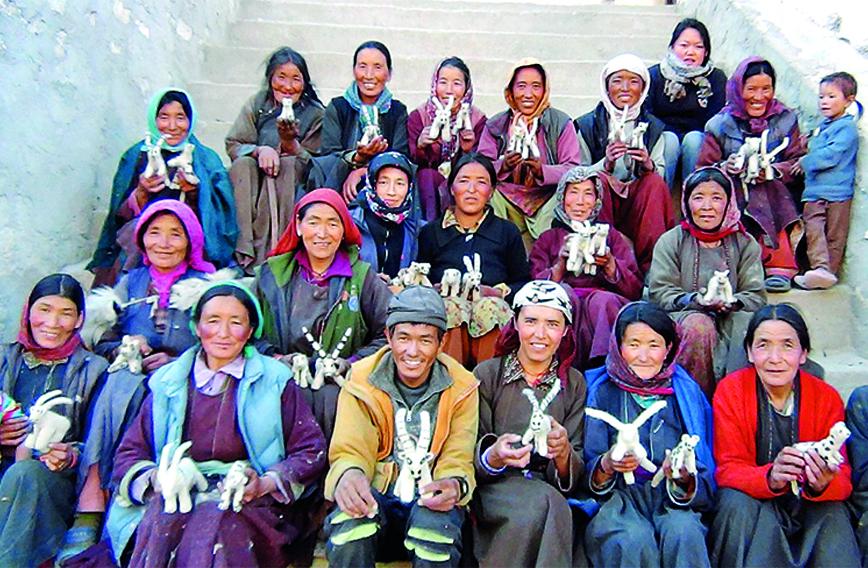
Ladakhis with handmade toys that are used for reviving folklore
In Ladakh, once upon a time
Stanzin Dothon, Phey, Ladakh
THERE were days when Ladakh remained completely cut off from the rest of the country for a minimum of six winter months. People would stay indoors for most of the time and had limited sources of entertainment. Families would spend time with one another and elders shared folklore with the children connecting them to their cultural heritage and imparting lessons on harmonious coexistence with nature.
With modernization penetrating the traditional societies of this ecologically sensitive region over several decades, the folklore have become fables. To preserve these stories, Tushar Sonkar, a 26-year-old student from the National Institute of Design, Andhra Pradesh (NID), embarked on an extraordinary mission called ‘Enju’. His passionate objective is to revive forgotten folklore centered around the harmonious coexistence of humans and wildlife, engaging community members in preserving this rich cultural heritage. Using hand-made puppets, which are created by Ladakhi women, he is making efforts to keep the tradition alive.
THE INSPIRATION
In the Ladakhi folklore tradition, the narrator opened his act with the sentence: Yodh yode sani or Yodh yodh sugle ju which roughly means “Once upon a time” to which the children would reply, En Ju as an affirmation to go ahead with the story. This helped the narrator keep checking if they were awake and listening. The storytelling would go on as long as the response was heard. If there was no response, it indicated that the children had fallen asleep. As a region that is home to many endangered species, Ladakh’s folklore teaches the new generation about the importance of coexisting peacefully with the diverse and fragile ecosystems surrounding them. This intrigued Sonkar so much that when, in 2021, he volunteered with the Snow Leopard Conservancy India Trust (SLC-IT), a Leh-based organization and was assisting them in training village women to make toys of felt, he thought of bringing these handmade toys and the vanishing folklore together.
Dry needle felting or needle punching is a fibre art method where unique barbed needles are used to craft felted designs or sculptures. SLC- IT has been collaborating with women in these Himalayan villages near the habitat of the snow leopard to create handmade toys that provide them a sustainable source of livelihood.
“After developing toys that can be used as puppets, we conducted pilot tests with school teachers to train them in puppet storytelling. We collaborated with the nature club of the Moravian Mission School in Leh, where students prepared a play on waste management, incorporating popular characters from Ladakhi folk stories. Another intervention was with the local food festival in the Himalayan Institute of Archaeology and Allied Sciences Ladakh (HIAAS) where SLC-IT assisted them in preparing small performances for the children in the audience. The performance aimed to raise awareness about the importance of local food and highlighted how packaged food contributes to plastic waste generation and health issues,” shared Sonkar.
WHY PUPPETS
Sonkar observed that puppets can be highly effective and engaging tools for entertainment, and they can also play a significant role in information retention for a long time. When folk stories about wildlife and ideal values are told to children using puppets representing locally found animals, a stronger emotional bond with nature develops within them. This emotional connection serves as a crucial catalyst, inspiring them to take their first step towards conservation.
While engaging closely with the women who create handmade toys, Sonkar saw that they were being used majorly for displays. He thought of using them as puppets for narrating the folklore and to build more interest and connection among the younger generation.
HOW IT BEGAN
Sonkar’s journey began in 2018 when he first visited Ladakh with the dream of encountering a snow leopard, locally known as shan. During his stroll in Leh, he discovered the Snow Leopard Conservancy-India Trust and engaged in informative and heartwarming conversations with the organization’s members. Although he didn’t spot a snow leopard then, he was determined to return.
In 2021, Sonkar dedicated one and a half years to volunteering with the organization, passionately contributing to snow leopard conservation efforts. During this time, he had a thrilling experience when Dr Tsewang Namgial, the founder of the organization, invited him to experience a snow leopard sighting in a nearby village. This encounter left a lasting impact on Sonkar, and he was filled with a sense of purpose.
Reflecting on his project, Sonkar expressed that he has successfully instilled the use of storytelling for wildlife conservation in the minds of Ladakhi teachers, students, and NGOs. Although he is no longer volunteering for the organization, they have adopted his storytelling method and continue to conduct workshops and storytelling sessions.
WHAT LIES AHEAD
Sonkar aspires to explore local folk stories from around the world and examine their connections to wildlife, nature, and ecological well-being. He believes that folk stories play a vital role in connecting us to our roots and bear witness to our ancestors’ lives. These tales not only depict the past but also provide valuable insights into how things have evolved. They highlight a simpler time when people lived in harmony with nature, serving as a medium for reflection and guiding us to make informed choices.
The writer is Charkha’s Volunteer Trainer from Phey, Ladakh. Charkha Features
Comments
-

Chandralekha Anand Sio - Aug. 31, 2023, 7:30 p.m.
Interest in folklore is slowly dying out among the younger generations.It is very important to revive it and keep it alive to be able to understand the past generations better. Folklore from different parts of the country and even the world should be introduced in schools to create interest in children who will be the generations to come.




